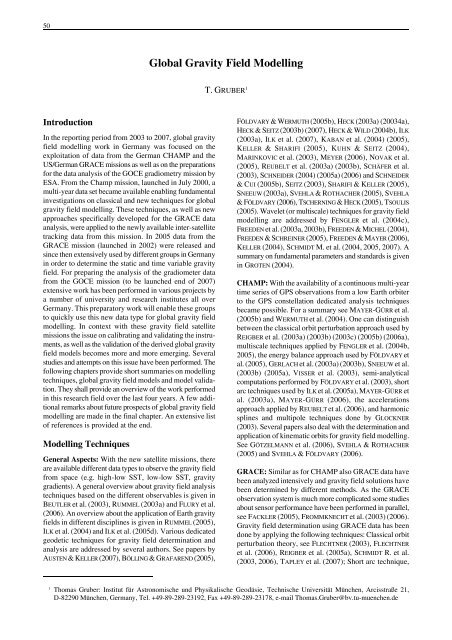NATIONAL REPORT OF THE FEDERAL REPUBLIC OF ... - IAG Office
NATIONAL REPORT OF THE FEDERAL REPUBLIC OF ... - IAG Office
NATIONAL REPORT OF THE FEDERAL REPUBLIC OF ... - IAG Office
You also want an ePaper? Increase the reach of your titles
YUMPU automatically turns print PDFs into web optimized ePapers that Google loves.
50<br />
Introduction<br />
In the reporting period from 2003 to 2007, global gravity<br />
field modelling work in Germany was focused on the<br />
exploitation of data from the German CHAMP and the<br />
US/German GRACE missions as well as on the preparations<br />
for the data analysis of the GOCE gradiometry mission by<br />
ESA. From the Champ mission, launched in July 2000, a<br />
multi-year data set became available enabling fundamental<br />
investigations on classical and new techniques for global<br />
gravity field modelling. These techniques, as well as new<br />
approaches specifically developed for the GRACE data<br />
analysis, were applied to the newly available inter-satellite<br />
tracking data from this mission. In 2005 data from the<br />
GRACE mission (launched in 2002) were released and<br />
since then extensively used by different groups in Germany<br />
in order to determine the static and time variable gravity<br />
field. For preparing the analysis of the gradiometer data<br />
from the GOCE mission (to be launched end of 2007)<br />
extensive work has been performed in various projects by<br />
a number of university and research institutes all over<br />
Germany. This preparatory work will enable these groups<br />
to quickly use this new data type for global gravity field<br />
modelling. In context with these gravity field satellite<br />
missions the issue on calibrating and validating the instruments,<br />
as well as the validation of the derived global gravity<br />
field models becomes more and more emerging. Several<br />
studies and attempts on this issue have been performed. The<br />
following chapters provide short summaries on modelling<br />
techniques, global gravity field models and model validation.<br />
They shall provide an overview of the work performed<br />
in this research field over the last four years. A few additional<br />
remarks about future prospects of global gravity field<br />
modelling are made in the final chapter. An extensive list<br />
of references is provided at the end.<br />
Modelling Techniques<br />
General Aspects: With the new satellite missions, there<br />
are available different data types to observe the gravity field<br />
from space (e.g. high-low SST, low-low SST, gravity<br />
gradients). A general overview about gravity field analysis<br />
techniques based on the different observables is given in<br />
BEUTLER et al. (2003), RUMMEL (2003a) and FLURY et al.<br />
(2006). An overview about the application of Earth gravity<br />
fields in different disciplines is given in RUMMEL (2005),<br />
ILK et al. (2004) and ILK et al. (2005d). Various dedicated<br />
geodetic techniques for gravity field determination and<br />
analysis are addressed by several authors. See papers by<br />
AUSTEN & KELLER (2007), BÖLLING & GRAFAREND (2005),<br />
Global Gravity Field Modelling<br />
T. GRUBER 1<br />
FÖLDVARY & WERMUTH (2005b), HECK (2003a) (20034a),<br />
HECK & SEITZ (2003b) (2007), HECK & WILD (2004b), ILK<br />
(2003a), ILK et al. (2007), KABAN et al. (2004) (2005),<br />
KELLER & SHARIFI (2005), KUHN & SEITZ (2004),<br />
MARINKOVIC et al. (2003), MEYER (2006), NOVAK et al.<br />
(2005), REUBELT et al. (2003a) (2003b), SCHÄFER et al.<br />
(2003), SCHNEIDER (2004) (2005a) (2006) and SCHNEIDER<br />
& CUI (2005b), SEITZ (2003), SHARIFI & KELLER (2005),<br />
SNEEUW (2003a), SVEHLA & ROTHACHER (2005), SVEHLA<br />
& FÖLDVARY (2006), TSCHERNING & HECK (2005), TSOULIS<br />
(2005). Wavelet (or multiscale) techniques for gravity field<br />
modelling are addressed by FENGLER et al. (2004c),<br />
FREEDEN et al. (2003a, 2003b), FREEDEN & MICHEL (2004),<br />
FREEDEN & SCHREINER (2005), FREEDEN & MAYER (2006),<br />
KELLER (2004), SCHMIDT M. et al. (2004, 2005, 2007). A<br />
summary on fundamental parameters and standards is given<br />
in GROTEN (2004).<br />
CHAMP: With the availability of a continuous multi-year<br />
time series of GPS observations from a low Earth orbiter<br />
to the GPS constellation dedicated analysis techniques<br />
became possible. For a summary see MAYER-GÜRR et al.<br />
(2005b) and WERMUTH et al. (2004). One can distinguish<br />
between the classical orbit perturbation approach used by<br />
REIGBER et al. (2003a) (2003b) (2003c) (2005b) (2006a),<br />
multiscale techniques applied by FENGLER et al. (2004b,<br />
2005), the energy balance approach used by FÖLDVARY et<br />
al. (2005), GERLACH et al. (2003a) (2003b), SNEEUW et al.<br />
(2003b) (2005a), VISSER et al. (2003), semi-analytical<br />
computations performed by FÖLDVARY et al. (2003), short<br />
arc techniques used by ILK et al. (2005a), MAYER-GÜRR et<br />
al. (2003a), MAYER-GÜRR (2006), the accelerations<br />
approach applied by REUBELT et al. (2006), and harmonic<br />
splines and multipole techniques done by GLOCKNER<br />
(2003). Several papers also deal with the determination and<br />
application of kinematic orbits for gravity field modelling.<br />
See GÖTZELMANN et al. (2006), SVEHLA & ROTHACHER<br />
(2005) and SVEHLA & FÖLDVARY (2006).<br />
GRACE: Similar as for CHAMP also GRACE data have<br />
been analyzed intensively and gravity field solutions have<br />
been determined by different methods. As the GRACE<br />
observation system is much more complicated some studies<br />
about sensor performance have been performed in parallel,<br />
see FACKLER (2005), FROMMKNECHT et al. (2003) (2006).<br />
Gravity field determination using GRACE data has been<br />
done by applying the following techniques: Classical orbit<br />
perturbation theory, see FLECHTNER (2003), FLECHTNER<br />
et al. (2006), REIGBER et al. (2005a), SCHMIDT R. et al.<br />
(2003, 2006), TAPLEY et al. (2007); Short arc technique,<br />
1 Thomas Gruber: Institut für Astronomische und Physikalische Geodäsie, Technische Universität München, Arcisstraße 21,<br />
D-82290 München, Germany, Tel. +49-89-289-23192, Fax +49-89-289-23178, e-mail Thomas.Gruber@bv.tu-muenchen.de











